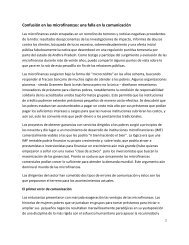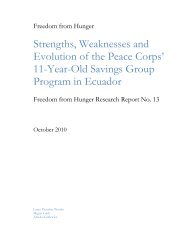Voices from the Frontlines: - Freedom from Hunger
Voices from the Frontlines: - Freedom from Hunger
Voices from the Frontlines: - Freedom from Hunger
Create successful ePaper yourself
Turn your PDF publications into a flip-book with our unique Google optimized e-Paper software.
EXECUTIVE SUMMARY<br />
Listening to <strong>the</strong> poor without preconceptions has generated remarkable insights about <strong>the</strong>ir desires,<br />
challenges and capabilities, with significant implications for designing programs that more effectively<br />
meet <strong>the</strong>ir needs. To complement <strong>the</strong>se efforts and <strong>the</strong> learning <strong>the</strong>y have generated, <strong>Freedom</strong> <strong>from</strong><br />
<strong>Hunger</strong> undertook a project to listen to <strong>the</strong> frontline fieldworkers; specifically, to listen to <strong>the</strong> credit<br />
officers of financial service providers who utilize <strong>the</strong> village-banking model as a platform to provide<br />
financial and non-financial services to groups of poor women.<br />
<strong>Freedom</strong> <strong>from</strong> <strong>Hunger</strong> worked with five microfinance institutions (MFIs) to conduct this research.<br />
All five have been partners in adopting value-added microfinance as a strategy to reach <strong>the</strong> poor.<br />
This means <strong>the</strong>y use village banking as a platform for reaching groups of primarily poor women, and<br />
<strong>the</strong>y provide <strong>the</strong>m with both financial and non-financial services—loans and savings opportunities<br />
in combination with health, business, financial education and/or health services. Almost 200<br />
interviews and focus-group discussions (FGDs) were conducted with credit officers, clients and<br />
supervisors to answer five key questions: 1) What motivates credit officers? 2) What is <strong>the</strong> state of<br />
<strong>the</strong> relationship between <strong>the</strong> credit officer and <strong>the</strong> client? 3) What can we learn <strong>from</strong> credit officers<br />
about <strong>the</strong> people <strong>the</strong>y serve? 4) How can we better support credit officers? and 5) How faithfully are<br />
programs, policies and procedures carried out by credit officers?<br />
In summary, we found credit officers of <strong>the</strong>se five institutions to be primarily socially motivated;<br />
<strong>the</strong>y work for <strong>the</strong>se organizations “to help people.” Their relationships with clients are crucial for<br />
client as well as organizational success. These relationships can ei<strong>the</strong>r make or break client<br />
recruitment and retention. Product designs and attributes can be of secondary importance or can<br />
help a credit officer build stronger relationships. Product attributes and relationships with credit<br />
officers are intertwined. The client’s relationship with <strong>the</strong> credit officer <strong>the</strong>refore deserves more<br />
attention than it normally receives when evaluating client satisfaction and outcomes.<br />
Credit officers are founts of information regarding client needs and client well-being. As <strong>the</strong>y spend<br />
three-quarters of <strong>the</strong>ir time in <strong>the</strong> field with clients, <strong>the</strong>ir direct interaction allows <strong>the</strong>m to hear, see<br />
and experience client needs directly. To play a more effective role, credit officers desire<br />
administrative efficiency, more training (mainly on <strong>the</strong> financial aspect of <strong>the</strong>ir job and on group<br />
management and conflict resolution), someone else to play <strong>the</strong> “collector” role when <strong>the</strong>re are<br />
repayment issues (due to negative impact of repayment problems on relationship dynamics) and<br />
more recognition for <strong>the</strong>ir efforts. While <strong>the</strong>y receive value <strong>from</strong> <strong>the</strong>ir work (because of <strong>the</strong>ir direct<br />
interaction with clients and seeing clients satisfied and <strong>the</strong>ir lives improving), credit officers have<br />
mixed perceptions of <strong>the</strong> value <strong>the</strong>ir organizations place on <strong>the</strong>ir opinions and <strong>the</strong>ir efforts. Some<br />
credit officers feel <strong>the</strong>ir direct supervisors value <strong>the</strong>m, but are not sure whe<strong>the</strong>r this extends to <strong>the</strong><br />
institution as a whole.<br />
There is an inherent tension for credit officers: <strong>the</strong>y have a stake in <strong>the</strong> well-being of <strong>the</strong>ir clients,<br />
but <strong>the</strong>y also must have a stake in <strong>the</strong>ir employer’s successes. While supervisors acknowledge that<br />
this tension exists, <strong>the</strong>y acknowledge that policies and procedures are put into place to ensure more















